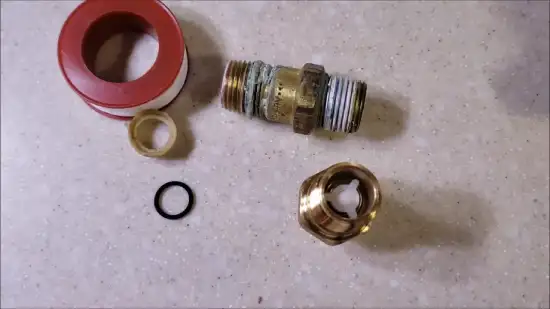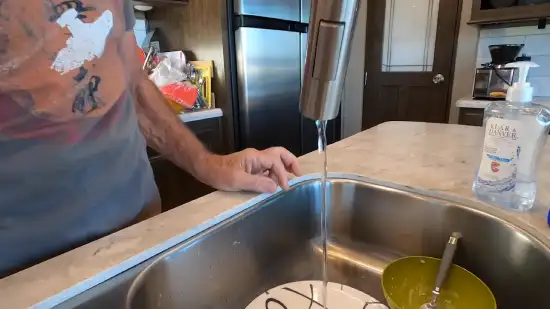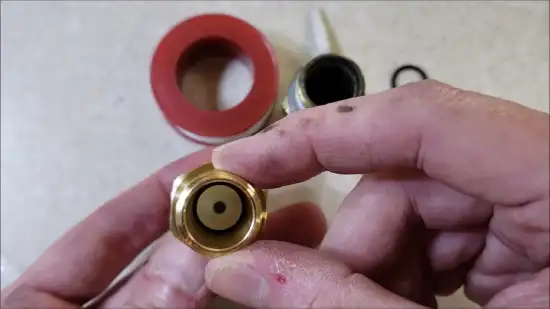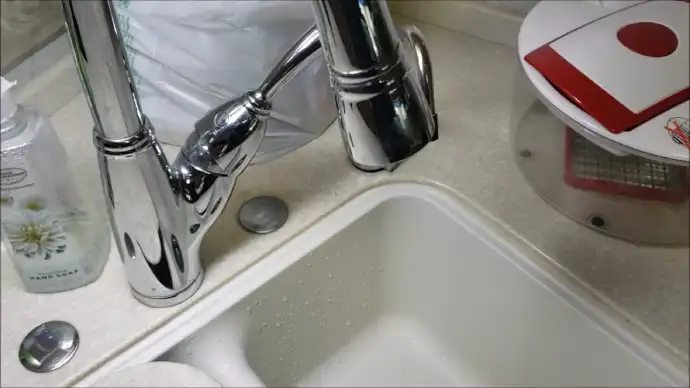Last Updated on December 24, 2023
Having low hot water pressure while on the road in your RV can be a real pain, especially for those who love traveling for extended periods. There can be various reasons behind the issue of low hot water pressure in an RV.
Some of the most common causes include sediment and debris build-up in the hot water tank, blocked shower heads, leaking hot water lines, and blocked hot water filters.
Understanding these causes is essential when searching for an effective solution to the problem. With proper maintenance, most of these issues can be easily spotted and resolved, allowing you to enjoy your travels to the fullest.
Let’s discover the causes and cures for low hot water pressure in RVs and preventive measures to overcome this problem for good.
What Causes Low Hot Water Pressure in RV: Common Reasons

A range of factors can cause low hot water pressure in an RV.
- 1. Sediment and Debris in the hot water Tank
- 2. Blockage in the Showerhead or Worn-out Taps
- 3. Water Leaks in Hot Water System
- 4. Blockages in Hot Water Filters
- 5. Faulty Tempering Valves
- 6. Experiencing Blocked Pipes
- 7. Incorrect Installation of the Hot Water System
#1. Sediment and Debris in the Hot Water Tank
Accumulation of sediment and debris in an RV’s hot water tank can impede hot water flow and lead to reduced pressure. This buildup occurs over time due to the minerals and other impurities present in the water.
As the water is heated, the minerals settle at the bottom of the tank, forming a layer of sediment. Over time, this layer can become thick enough to restrict water flow through the tank’s pipes and cause low hot water pressure.
The sediment and debris buildup can also lead to other problems in the RV’s hot water system. It can cause hot spots in the tank, damaging it and reducing its lifespan. Additionally, the sediment can clog the tank’s drain valve, making it difficult to drain and flush the tank.
#2. Blockage in the Showerhead or Worn-out Taps
RV hot water flow can be hindered due to blockages or wear and tear in specific outlets such as showerheads and faucets. With time, mineral deposits and debris may accumulate inside the showerheads and faucets, causing a decline in water pressure.
This leads to an uncomfortable showering experience and inefficient dishwashing. Old and frequently used faucets can also cause a decline in hot water pressure by developing leaks or cracks. Because of this, hot water escapes before it reaches the outlet, causing an inconsistent flow and a decline in water pressure.
#3. Water Leaks in the Hot Water System
The presence of water leaks in the RV’s hot water system can cause a drop in the water flow, which can negatively affect the RV’s water system. It can happen in the tank or pipes of the hot water system and cause a loss of hot water and water pressure.
Leaking water can also damage the RV’s interior if it seeps into walls and floors, causing mold and mildew. One should frequently examine the hot water system for leaks and address them promptly to avoid these issues. It involves checking for leaks in pipes and fittings while monitoring the water temperature and pressure.
#4. Blockages in Hot Water Filters
Blocked filters in hot water systems can hinder water flow and adversely affect an RV’s plumbing system. These filters effectively prevent debris from entering the hot water system and causing damage. If not maintained, they can become clogged and obstruct hot water flow, leading to low-pressure issues.
To avoid such blockages, it is crucial to perform regular filter inspections and cleanings. Simply washing the filter under running water or employing a cleaning solution can effectively clean it. Timely replacement of filters is equally important to ensure continued functionality.
#5. Faulty Tempering Valves
Faulty tempering valves in an RV’s plumbing system can cause issues with regulating water temperature, hindering the system’s overall functionality. These valves keep the hot water supply at a consistent temperature as it moves through the RV.
Malfunctioning valves may affect the flow of hot water, leading to low pressure. The valves work by mixing hot and cold water to maintain a steady temperature and prevent scalding. When they don’t function correctly, the hot water temperature may fluctuate, causing discomfort and potential harm.
Also, faulty tempering valves may lead to low pressure and a limited hot water supply. Keeping them in good working condition is crucial to ensure a steady supply of hot water inside the RV.
#6. Experiencing Blocked Pipes
Blocked pipes in an RV’s hot water system can occur due to debris, rust, calcium deposits, and sediment accumulation. These blockages are often seen in systems that draw water from wells or sources with high mineral content.
When water is heated, minerals can settle in the pipes, gradually reducing their diameter and restricting water flow, resulting in low pressure. Aging hot water systems can also corrode, leading to the accumulation of rust mixing with debris.
If an RV is unused for an extended period, stagnant water can produce sediment. Regular flushing of the system can prevent the formation of blockages, ensuring continuous flow and pressure of hot water within the RV.
#7. Incorrect Installation of the Hot Water System
Improper RV hot water system installation can cause reduced efficiency and inconvenience for owners, resulting in an unsatisfactory camping experience. A common cause of low hot water pressure is too small pipes, bends that create resistance to water flow, or an incorrect water heater placement.
To ensure proper water flow without reducing pressure and make maintenance and repairs easier, installing the water heater at the correct height is vital. Proper hot water system installation is essential to provide RV owners a comfortable and enjoyable camping experience.
What Can Be Done to Improve the RV’s Low Water Pressure?

Several things can be done to fix low water pressure in an RV. The following are some essential steps to take:
ONE: Adjust the Water Pressure at the Spigot
To improve the hot water pressure in your RV, consider adjusting the water pressure at the spigot. This can be done by using a pressure regulator device that can be attached to the spigot. Adjusting the regulator can increase or decrease water pressure and improve the water flow in your RV.
Note: It’s crucial to note that increasing the water pressure too much can damage the RV’s plumbing. Before adjusting the water pressure, consult the RV manufacturer’s guidelines or a professional.
TWO: Notify Campground Staff about Low-Pressure Issues
If your RV has consistently low water flow, it’s important to notify the campground staff. This can help identify and resolve any underlying issues causing the problem. Various factors can affect hot water pressure, as we mentioned above.
Once you inform the staff, they can investigate the issue and take the necessary steps to address it. They can adjust the water pressure at the source, check for damages or leaks in the water lines, and test the water quality to ensure it’s safe for use. They may need to call a professional plumber to fix any underlying issues.
THREE: Check for Leaks in the Fresh Water Hose
Check the freshwater hose for leaks to maintain proper water flow in your RV and a comfortable camping experience. Leaks can cause low water pressure in an RV, affecting your overall experience. Checking the hose is easy and requires a few steps.
Start by turning off the water supply and draining the hose. Next, inspect the hose thoroughly, looking for any damage like cracks, holes, or other signs of wear. Mark any leaks you find with a piece of tape or marker to help you locate them later.
FOUR: Replace or Clean Clogged Water Filters/Strainers
Cleaning or replacing clogged water filters and strainers is a crucial maintenance task for RV owners to ensure a steady and safe water supply. Over time, these filters and strainers can become congested with dirt and debris, resulting in low water pressure and restricted flow.
If you rely on a constant supply of hot water in your RV, this can be pretty annoying. Therefore, it’s necessary to inspect these filters and strainers regularly and clean or replace them accordingly.
This procedure involves removing them from the water line, flushing them with clean water, and either reinstalling them or replacing them with brand-new ones. Doing so can improve water flow in their RV and ensure that their water supply is free from harmful contaminants.
Does a bad pressure relief valve affect RV water pressure?
A bad pressure relief valve can impact the water pressure in an RV. The pressure relief valve regulates the water pressure in the RV’s plumbing system and opens up to release excess pressure when the limit is reached. If it is not working correctly, it can cause a drop in water pressure or in severe cases, no water at all.
It is important to have a licensed plumber assess the condition of the PRV if low water pressure occurs. They can determine if the PRV affects the water pressure or needs adjustment or replacement.
Attempting to fix it with proper training is recommended. Seeking the assistance of a professional plumber will ensure the problem is resolved correctly.
What are the signs of a bad hot water pressure valve?

Regarding hot water pressure valves in RVs, several signs indicate a malfunctioning valve. Signs of this condition include:
1. Excessive Noise
Excessive noise from an RV’s water heater could mean the pressure relief valve is malfunctioning. This valve releases pressure in the hot water system to prevent damage. A bad valve can lead to a rattling or high-pitched whistling noise heard throughout the RV.
This noise is frustrating and indicates the need for valve replacement. Inspection of the valve and system is crucial to identify the issue. A technician should replace faulty valves immediately. Ignoring the noise can cause further damage to the hot water system and pose safety hazards.
2. Debris in Water
Debris in the valve can affect its efficiency, causing issues for RV owners. Sediment, rust, or mineral accumulation can cause clogging, decreasing water flow and pressure. This can also lead to more wear and tear, which can be expensive to repair or replace.
As a preventive measure, the hot water system requires regular maintenance, including flushing and valve cleaning. Monitoring the quality of the water supply is also important to prevent the accumulation of debris. Taking timely action to prevent debris buildup can help RV owners avoid costly repairs and replacements.
3. Ruptured Tank
Tank rupture in water heaters can occur due to untreated pressure buildup and faulty relief valves. When pressure builds up inside the water heater and is not released in time, the tank may rupture, causing water to leak from the seams. This can lead to severe damage to the surrounding area and pose a safety hazard.
Tank relief valves release excess pressure, but if they don’t work right, pressure can build up, causing the tank to burst. Therefore, it is critical to check and replace malfunctioning relief valves regularly.
4. Leaking
One potential issue with a water heater’s pressure relief valve is a constant and significant amount of water leakage. The problem can be caused by a faulty valve, too much pressure in the tank, or overheating. If left unchecked, the constant leakage of hot water can lead to significant water wastage and high utility bills.
In some cases, the leakage may be due to a malfunctioning valve that fails to regulate the pressure inside the water heater. This can cause excess pressure to build up, leading to leaks or even ruptures in the tank.
In other cases, the water heater may be overheating due to a malfunctioning thermostat or other components. This can cause the water to expand and increase the pressure inside the tank, leading to leaks from the pressure relief valve.
What’s the location of the RV water pressure valve?
To properly regulate water pressure in an RV, locating the regulator valve in the correct position is essential. This valve is crucial in decreasing the water pressure to a safe level, preventing damage to the plumbing system, and maintaining water flow and pressure.
The valve’s function is to keep water pressure at a safe level and is placed in-between the freshwater hose and the water source.
Incorrect installation of the regulator may cause issues in the RV plumbing system. Therefore, proper placement and installation of the valve are paramount to achieving the desired water flow and pressure, giving you an enjoyable and worry-free RVing experience.
When should a pressure relief valve be replaced?
Pressure relief valves play a crucial role in ensuring the safety of pressurized systems by preventing overpressure conditions. These valves are designed to open and release pressure when it exceeds a predetermined limit, keeping the system operating safely.
However, pressure relief valves can deteriorate over time due to corrosion, wear, and tear, or exposure to extreme temperatures and pressures. This can result in leaks or inadequate operation, potentially compromising the system’s safety.
Pressure relief valves must be regularly inspected and tested to ensure they work properly and protect against overpressure. If a valve begins to leak or requires frequent repairs, it must be replaced to maintain optimal performance.
Avoid Deal-Breakers: Tackle Low Hot Water Pressure in Your RV
Embarking on a road trip with your RV is a perfect way to explore the outdoors and stay mentally healthy. However, low hot water pressure can be a deal-breaker during such a trip. It’s vital to understand the root cause of the problem and take proactive steps to fix it.
There could be various reasons behind low hot water pressure, including clogs, a broken water pump, or a damaged pressure relief valve. Following the procedure mentioned above can solve the issue. But if it persists, it’s best to get the water pump and pressure relief valve checked for any potential damage.
Routine maintenance goes a long way in ensuring your RV’s water system functions smoothly and provides constant hot water pressure. So, remember to diagnose and maintain your RV’s water supply system for an unforgettable adventure.



